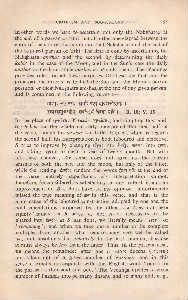Page 683 - Lokmanya Tilak Samagra (khand 2)
P. 683
CRITICISM AND SUGGESTIONS 35
In other words we have to ascertain not only the Nahhatra at
the end of a parvan or tithi, but also the time elapsed between the
entry of the sun or the moon into that Nak~hatra and the end of
the required parvan or tithi. The first is done by ascertaining the
Nak~hatra amshas and the second by determining the daily
kalas in the case of the Moon, and in the Sun's case the daily
amshas or the hour angle amshas as B calls them. The Vedanga
provides rules for all these purposes. Of these the first and the
principal one directs us to find the Sun and the Moon's parvan
position, or their Nak~hatra amshas, at the end of any given parvan,
and is contained in the following verses :-
mm: ~~: ~11T: qm [l~'fl"h\crr: I
~~iJf~l{R: ~s~ :%l~crr 11-R II R. 101 Y. 15
In the place of ~w!or: Y reads o~~fif:, and adopting this read-
ing B has on the whole correctly interpreted the first half ot
the verse, though his anvaya is a little strained; while as regards
the second half, his interpretation is both laboured and defective.
S tries to improve by changing wlof: into ~;:;U:, 31~<r.r: into ll:~r:
and taking ~fCGl'fi to mean a year of twelve months. But with
all these changes, the verse does not give us the parvan
amshas of both the sun and the moon, but only of the latter,
while the reading ~;:iJ: renders the words ~·n ll"fi:: at the end of
the verse entirely superfluous. S's interpretation cannot,
therefore, be considered as satisfactory; at any rate it is rtot an
improvement on B's. Both have, in my opinion, unfortunately
missed the true meaning of ~ in this verse, and that is the
main cause of the laboured construction adopted by one and the
bold emendations proposed by the other. ~ does not here
signify ' minus' as B takes it, nor is it necesasary to be
altered into ~;:;U: as S has done. i31if literally means ' less' or
' remaining '; and when we take out a number or its complete
multiples from another what remains may very well be called
~. not absolutely but relatively to the first number, because
it must always be less than the latter. Thus, in the present case,
~ means the remainder after one or more dozens ( ~~'fi )
are taken out of a given number of Pakshas; and in this
sense it exactly corresponds with the English word 'odd', in
the phrase 'a thousand and odd.' The Vedanga divides a given
number of Pakshas into _so many dozens ~nd so many odd, e. g.,

